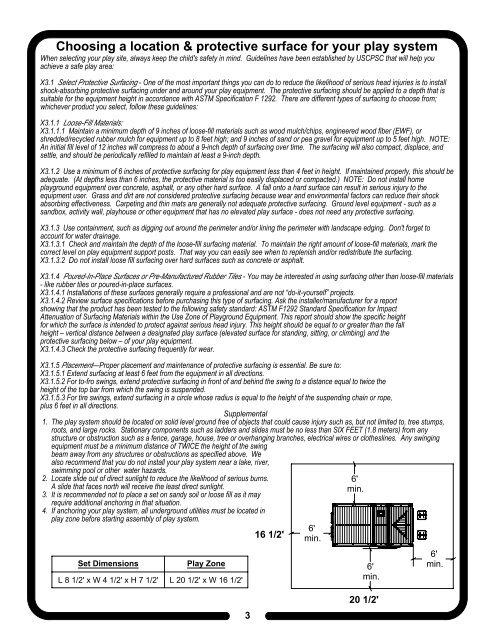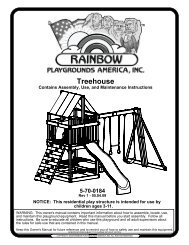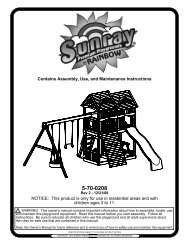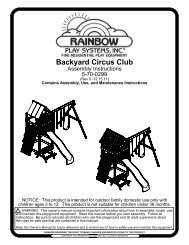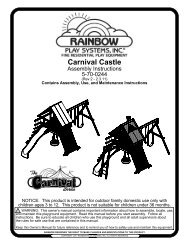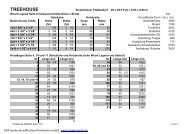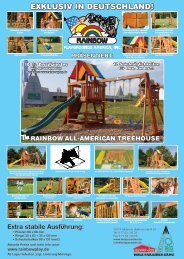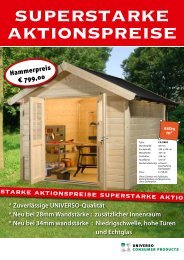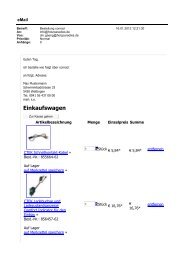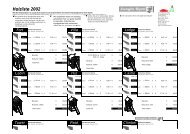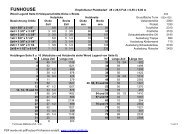Fiesta Playhouse Hardware List
Fiesta Playhouse Hardware List
Fiesta Playhouse Hardware List
Create successful ePaper yourself
Turn your PDF publications into a flip-book with our unique Google optimized e-Paper software.
Choosing a location & protective surface for your play system<br />
When selecting your play site, always keep the child's safety in mind. Guidelines have been established by USCPSC that will help you<br />
achieve a safe play area:<br />
X3.1 Select Protective Surfacing - One of the most important things you can do to reduce the likelihood of serious head injuries is to install<br />
shock-absorbing protective surfacing under and around your play equipment. The protective surfacing should be applied to a depth that is<br />
suitable for the equipment height in accordance with ASTM Specification F 1292. There are different types of surfacing to choose from;<br />
whichever product you select, follow these guidelines:<br />
X3.1.1 Loose-Fill Materials:<br />
X3.1.1.1 Maintain a minimum depth of 9 inches of loose-fill materials such as wood mulch/chips, engineered wood fiber (EWF), or<br />
shredded/recycled rubber mulch for equipment up to 8 feet high; and 9 inches of sand or pea gravel for equipment up to 5 feet high. NOTE:<br />
An initial fill level of 12 inches will compress to about a 9-inch depth of surfacing over time. The surfacing will also compact, displace, and<br />
settle, and should be periodically refilled to maintain at least a 9-inch depth.<br />
X3.1.2 Use a minimum of 6 inches of protective surfacing for play equipment less than 4 feet in height. If maintained properly, this should be<br />
adequate. (At depths less than 6 inches, the protective material is too easily displaced or compacted.) NOTE: Do not install home<br />
playground equipment over concrete, asphalt, or any other hard surface. A fall onto a hard surface can result in serious injury to the<br />
equipment user. Grass and dirt are not considered protective surfacing because wear and environmental factors can reduce their shock<br />
absorbing effectiveness. Carpeting and thin mats are generally not adequate protective surfacing. Ground level equipment - such as a<br />
sandbox, activity wall, playhouse or other equipment that has no elevated play surface - does not need any protective surfacing.<br />
X3.1.3 Use containment, such as digging out around the perimeter and/or lining the perimeter with landscape edging. Don't forget to<br />
account for water drainage.<br />
X3.1.3.1 Check and maintain the depth of the loose-fill surfacing material. To maintain the right amount of loose-fill materials, mark the<br />
correct level on play equipment support posts. That way you can easily see when to replenish and/or redistribute the surfacing.<br />
X3.1.3.2 Do not install loose fill surfacing over hard surfaces such as concrete or asphalt.<br />
X3.1.4 Poured-In-Place Surfaces or Pre-Manufactured Rubber Tiles - You may be interested in using surfacing other than loose-fill materials<br />
- like rubber tiles or poured-in-place surfaces.<br />
X3.1.4.1 Installations of these surfaces generally require a professional and are not “do-it-yourself” projects.<br />
X3.1.4.2 Review surface specifications before purchasing this type of surfacing. Ask the installer/manufacturer for a report<br />
showing that the product has been tested to the following safety standard: ASTM F1292 Standard Specification for Impact<br />
Attenuation of Surfacing Materials within the Use Zone of Playground Equipment. This report should show the specific height<br />
for which the surface is intended to protect against serious head injury. This height should be equal to or greater than the fall<br />
height – vertical distance between a designated play surface (elevated surface for standing, sitting, or climbing) and the<br />
protective surfacing below – of your play equipment.<br />
X3.1.4.3 Check the protective surfacing frequently for wear.<br />
X3.1.5 Placement—Proper placement and maintenance of protective surfacing is essential. Be sure to:<br />
X3.1.5.1 Extend surfacing at least 6 feet from the equipment in all directions.<br />
X3.1.5.2 For to-fro swings, extend protective surfacing in front of and behind the swing to a distance equal to twice the<br />
height of the top bar from which the swing is suspended.<br />
X3.1.5.3 For tire swings, extend surfacing in a circle whose radius is equal to the height of the suspending chain or rope,<br />
plus 6 feet in all directions.<br />
Supplemental<br />
1. The play system should be located on solid level ground free of objects that could cause injury such as, but not limited to, tree stumps,<br />
roots, and large rocks. Stationary components such as ladders and slides must be no less than SIX FEET (1.8 meters) from any<br />
structure or obstruction such as a fence, garage, house, tree or overhanging branches, electrical wires or clotheslines. Any swinging<br />
equipment must be a minimum distance of TWICE the height of the swing<br />
beam away from any structures or obstructions as specified above. We<br />
also recommend that you do not install your play system near a lake, river,<br />
swimming pool or other water hazards.<br />
2. Locate slide out of direct sunlight to reduce the likelihood of serious burns.<br />
A slide that faces north will receive the least direct sunlight.<br />
3. It is recommended not to place a set on sandy soil or loose fill as it may<br />
require additional anchoring in that situation.<br />
4. If anchoring your play system, all underground utilities must be located in<br />
play zone before starting assembly of play system.<br />
Set Dimensions Play Zone<br />
L 8 1/2' x W 4 1/2' x H 7 1/2' L 20 1/2' x W 16 1/2'<br />
3<br />
16 1/2'<br />
6'<br />
min.<br />
6'<br />
min.<br />
6'<br />
min.<br />
20 1/2'<br />
6'<br />
min.


